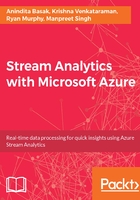
Services offered by Microsoft
The following is a very well-known classification of the different type of services offered by Microsoft for on-premises and the cloud. Microsoft Azure provides a full spectrum of services starting with Infrastructure as a Service (IaaS), followed by Platform as a Service (PaaS) and Software as a Service (SaaS) models such as Dynamics CRM, Office 365, and so on:

Service classification model
With IaaS, customers can deploy a virtual machine of their choice without the complexity of buying and managing their own hardware/software; they can quickly scale up and down with demand and pay only for what they use. This will reduce operational expenses of hosting and managing infrastructure.
Azure provides a vast range of PaaS services such as web apps, logic apps, media apps, API apps, mobile apps, Azure Stream Analytics, Azure HDInsight, and Azure Redis Cache. PaaS services like PowerApps are targeted at business users to create simple mobile apps and business workflows, without requiring any knowledge of a programming language. PaaS is an exciting model, where Microsoft will take care of all the core infrastructure to the point where the application and data become the responsibility of the customer.
One most common question is whether a customer should choose between IaaS versus PaaS. The comparison itself forms a very vast subject. Let's focus on the key point of the trade-off between them. One key trade-off is between speed and control within the cloud environment. PaaS-based services offer less control over infrastructure components but offer high velocity in terms of speed of deployment and easier maintenance (example: automated patching of the guest OS). On the other hand, the traditional IaaS-based deployment model is build using a virtual machine (VM), as they offer the most control in the cloud environment.
Azure provides customers with multiple entry points that give them different agility, control, and flexibility in their development and production environment. What that means for customers is that they have more choices in building their application and different entry points along a control-speed continuum. Our primary focus for this book is PaaS based streaming solution based on Azure Stream Analytics. Let's go deep into the topic in the next section.